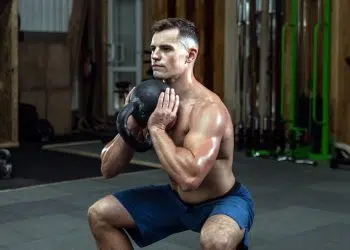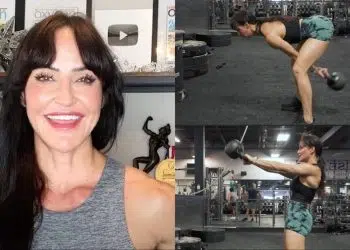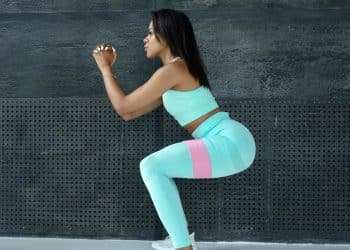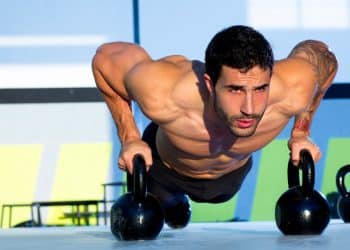Love ‘em or hate ‘em squats deserve a place in almost everybody’s workout. No exercise works your legs like squats, and in terms of muscle and strength-building potential, they’re hard to beat.
However, while most people’s go-to squat variations are barbell front and back squats, there are plenty of other ways to perform the king of exercises.
In this guide, we lift the lid on kettlebell sumo squats. Add this exercise to your leg workouts to light up your glutes and hammer your inner thighs and quads. It’s super safe and the perfect movement for home lifters.
Kettlebell Sumo Squat – Muscles Worked
Kettlebell sumo squats are a compound leg exercise, meaning they work multiple muscles and involve two or more joints. In fact, this move works virtually every muscle from your waist down.
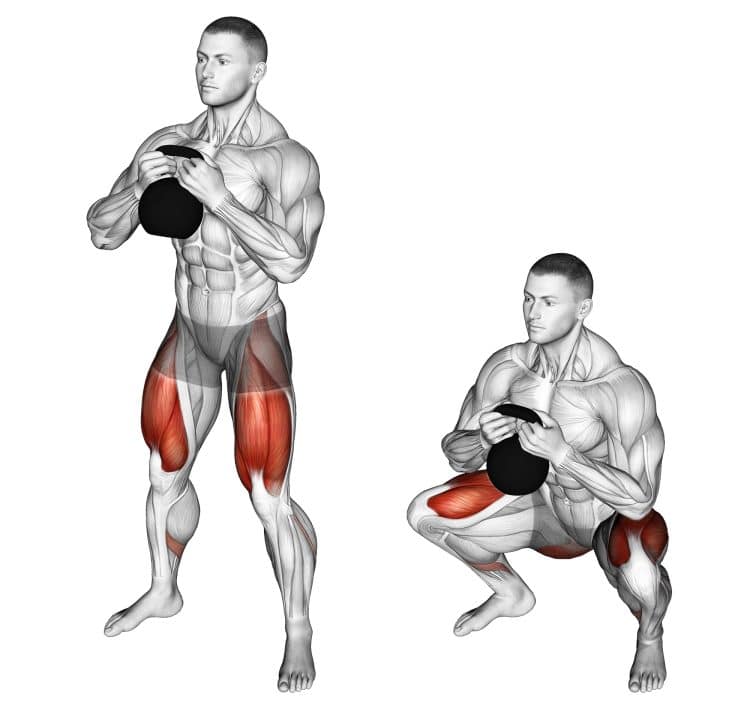
The main muscles trained during sumo kettlebell squats are:
Quadriceps
The quadriceps, or quads for short, is a group of four muscles that are responsible for extending your knees. The four quads are the rectus femoris, vastus lateralis, vastus medialis, and vastus intermedius.
Level Up Your Fitness: Join our 💪 strong community in Fitness Volt Newsletter. Get daily inspiration, expert-backed workouts, nutrition tips, the latest in strength sports, and the support you need to reach your goals. Subscribe for free!
Gluteus maximus
Known as the glute max for short, this is the largest and strongest muscle in the human body. Basically your butt, the glute max is responsible for hip extension, but some of its fibers are also involved in hip adduction and abduction, as well as external rotation.
Hamstrings
Located on the back of your thighs, the hamstrings are a group of three muscles that are responsible for knee flexion and hip extension. The three hamstring muscles are the semimembranosus, semitendinosus, and biceps femoris.
Abductors
The abductor muscles lift your legs out and away from the midline of your body. Wide-stance sumo squats are very abductor-centric. The main abductor muscles are the gluteus minimus and medius and the tensor fascia latae. These muscles or located on the side of your hip and thigh.
Adductors
The adductors are located on the inside of your thighs, and there are three of them – longus, brevis, and magnus. The role of the adductors is to draw your legs into the midline of your body. Sumo squats require and develop good adductor flexibility.
Core
Core is the collective name for the muscles of your midsection, including the rectus abdominis, obliques, transverse abdominis, and erector spinae. These muscles support and stabilize your lumbar spine during sumo squats, preventing unwanted movement, such as leaning sideways or rounding your lower back.
Other muscles
While Kettlebell sumo squats are predominately a leg exercise, there are upper body muscles involved, too. These include:
- Forearms
- Biceps
- Deltoids
- Trapezius
- Rhomboids
- Latissimus dorsi
However, unless you use a VERY heavy dumbbell, none of these muscles work particularly hard and won’t get much of a workout. So, if you want to train your upper body, you should target it directly with pushing and pulling exercises.
How to Do Kettlebell Sumo Squats
Get more from kettlebell sumo squats while keeping your risk of injury to a minimum by following these guidelines:
- Hold a kettlebell by the top handle with an overhand, narrow grip.
- Step out into a wide stance with your feet roughly one and a half shoulder widths apart.
- Point your toes slightly outward, so they face in the same direction as your knees.
- Brace your core and pull your shoulders back and down.
- Starting with the kettlebell in front of your hips, bend your knees and squat down, lowering the weight to the floor. Push your knees out and open your hips as you descend.
- Do NOT round your lower back. Keep your chest up and shoulders back throughout.
- Drive your feet into the floor and stand back up. Do not lean back at the top of the rep.
- That’s one – keep going!
Tips:
- Experiment with the width of your feet to see what works best for you.
- Increase glute and adductor activation by using a booty band around your knees.
- Start your rep with the kettlebell resting on the floor if you wish.
- Use gym chalk or lifting straps for a more secure grip if necessary.
- You can also do this exercise with a dumbbell standing on its end, like this:
Kettlebell Sumo Squat Benefits
Not convinced kettlebell sumo squats deserve a place in your workouts? Consider these benefits and then decide!
Easy to learn
The sumo kettlebell squat is quite a natural movement. It mimics how most people will stand and bend down to pick a weight off the floor, such as a grocery bag or child. As such, it’s usually easier to learn than the barbell front or back squat, which can feel unnatural and even slightly intimidating at first.
Lower back-friendly
Unlike barbell back squats, kettlebell sumo squats put relatively little pressure on your lower back. Your torso tends to remain more upright, which means less stress for your lumbar spine. As such, this is an excellent exercise for lifters wishing to avoid lower back pain.
Train to failure in safety
With no barbell resting on your back, you can push your muscles to failure without having to worry about getting pinned under a heavy weight. Simply lower or drop the weight to the floor when you’ve reached your limit.
No squat rack required
Unless you are proficient in the Steinborn squat, most weighted squat exercises are best done using a squat or power rack. That’s no problem if you train in a gym, but home lifters may not have access to such equipment. With no squat rack required, you can do kettlebell sumo squats at home, or anyplace you can find a kettlebell to train with.
Drawbacks
While kettlebell sumo squats are a mostly beneficial exercise, there are also a couple drawbacks to consider:
Limited overload
Kettlebells are available in a range of weights but tend to top out at around 85-100 pounds in most gyms. Heavier kettlebells are available, but they’re a rarity rather than the norm. As such, you may find that your gym doesn’t have big enough kettlebells to challenge you.
Grip strength may be a limiting factor
If your grip isn’t strong enough, you could find that your hands fail before your legs during kettlebell sumo squats. This is especially true if you use heavy weights. You may need to use lifting straps to overcome this drawback.
7 Kettlebell Sumo Squat Variations and Alternatives
Kettlebell sumo squats are a highly effective lower-body exercise, but that doesn’t mean you need to do them all the time. There are several variations and alternatives you can use to keep your workouts productive and interesting:
1. Kettlebell goblet sumo squats
One of the main drawbacks of regular kettlebell sumo squats is that your grip can stop you from lifting heavy weights or doing the maximum number of reps. Doing sumo squats with your kettlebell in the goblet position eliminates this problem, leaving you free to focus on working your legs to their limit.
Steps:
- Hold your kettlebell in front of your chest using a neutral, thumbs-up grip. Pull your upper arms into your sides. Brace your core and pull your shoulders back and down.
- Step out into a wide stance with your feet roughly one and a half shoulder widths apart. Point your toes slightly outward. Brace your core and pull your shoulders back and down.
- Bend your knees and squat down, descending until your thighs are parallel to the floor. Do NOT round your lower back. Keep your chest up and shoulders back throughout.
- Drive your feet into the floor and stand back up. Do not lean back at the top of the rep.
- Continue for the desired number of reps.
Muscles Targeted:
- Primary: Quadriceps, gluteus maximus, hamstrings, abductors, adductors.
- Secondary: Core.
Benefits:
- A better position for lifting heavier weights.
- Grip is less of a limiting factor than with regular kettlebell sumo squats.
- More core engagement.
Tips:
- Chalk your hands before each set to prevent the weight from slipping.
- Raise your heels on weight plates or low blocks to increase squat depth.
- Adjust the position of your feet to find your ideal stance.
2. Barbell sumo squat
If you want to lift the heaviest possible weights, barbell sumo squats are the way to do it. Perform this exercise in a squat rack for safety, as getting stapled under a heavy barbell can cause serious injuries.
Steps:
- Rack and hold a barbell across your upper back. Make sure it’s resting on your traps and not your neck.
- Step out and into a wide stance with your feet roughly one and a half shoulder widths apart, toes and knees turned slightly outward.
- Brace your core.
- Bend your knees and squat down until your thighs are roughly parallel to the floor. Push your knees out and open your hips as you descend.
- Drive your feet into the floor and stand back up.
- Continue for the prescribed number of reps.
Muscles Targeted:
- Primary: Quadriceps, gluteus maximus, hamstrings, abductors, adductors.
- Secondary: Core.
Benefits:
- A better exercise for lifting heavier weights than kettlebell sumo squats.
- A safe exercise providing you do it in a squat or power rack.
- An excellent alternative to kettlebell sumo squats.
Tips:
- Imagine you are spreading the floor with your feet to maximize hip abductor and glute engagement.
- Use a booty band to work your hips and glutes harder.
- Experiment with your stance width to see what works best for you.
3. Plie squats
Not everyone wants to lift heavy weights. In fact, for some exercisers, it’s unnecessary and may even be dangerous. If you have knee pain, hip pain, are an older exerciser, or are more into fitness than bodybuilding, you don’t need to load up with heavy bars and kettlebells. Plie squats are a bodyweight exercise, so they’re ideal for less hardcore lifters and exercisers.
Level Up Your Fitness: Join our 💪 strong community in Fitness Volt Newsletter. Get daily inspiration, expert-backed workouts, nutrition tips, the latest in strength sports, and the support you need to reach your goals. Subscribe for free!
Steps:
- Stand with your feet wider than shoulder-width apart.
- Turn your toes outward to about 45 degrees, ensuring your knees and feet point in the same direction.
- Stand up tall, brace your abs, and look straight ahead.
- Keeping your torso upright, bend your legs, push your knees out, and descend until your thighs are roughly parallel to the floor. Do not allow your lower back to round.
- Stand back up and repeat.
Muscles Targeted:
- Primary: Quadriceps, gluteus maximus, hamstrings, abductors, adductors.
- Secondary: Core.
Benefits:
- An excellent warm-up exercise for weighted sumo squats.
- Ideal for beginners.
- An effective hip mobility exercise.
Tips:
- Use a booty band to increase glute and abductor engagement.
- Raise your arms out to the sides as you descend for better balance.
- Lift your heels and balance on your toes for a more balletic movement.
4. Sumo deadlift
The barbell sumo deadlift is very similar to kettlebell sumo squats. In fact, if you start your kettlebell sumo squat with the weight resting on the floor, it actually IS a deadlift! Regardless, the barbell sumo deadlift is an excellent hip and glute exercise and is far easier on your lower back than conventional deadlifts.
Steps:
- With your barbell on the floor, stand behind it bar and take a wide stance so your feet are close to the weight plates. Turn your toes out slightly. The bar should be almost touching your shins.
- Bend over and hold the bar with a shoulder-width overhand grip. Your back should be slightly arched, core braced, arms straight, shoulders down and back, and hips higher than your knees.
- Without rounding your lower back, drive your feet into the floor and extend your knees. Keep the bar close to your legs.
- Thrust your hips forward as the bar passes your knees to finish the movement.
- Stand up straight but do not lean back or bend your arms, both of which could cause serious injury.
- Push your hips back, bend your knees, and lower the weight back to the floor.
- Allow the weight to settle briefly, reset your core and grip, and then repeat.
Read more about the sumo deadlift here.
Muscles Targeted:
- Primary: Quadriceps, gluteus maximus, hamstrings, abductors, adductors.
- Secondary: Core.
Benefits:
- A safer way to lift heavier weights than sumo squats.
- Emphasizes the posterior chain more than sumo squats.
- One of the official lifts in powerlifting.
Tips:
- Wear flat shoes or lift in your socks to stop your feet from rolling outward.
- Use a mixed grip when lifting heavy loads as it’s more secure.
- Wear a weightlifting belt to support and protect your lower back during heavy sumo deadlifts.
Related: Sumo vs. Conventional Deadlifts
5. Lateral lunges
Lateral or side lunges are a sort of one-legged sumo squat. Moving sideways means you’ll be working your glutes and hips in abduction and adduction, just like kettlebell sumo squats. However, emphasizing one leg at a time means more overload for the target muscles and an opportunity to identify and fix left-to-right strength imbalances.
Steps:
- Stand with your feet together and your arms by your sides. Brace your core, pull your shoulders down and back, and look straight ahead.
- Take a large step out to one side and bend your outermost leg. Descend until your thigh is roughly parallel to the floor. Keep your opposite leg straight.
- Push off your bent leg and return to the starting position.
- Do your next rep to the opposite side.
- Alternate legs for the duration of your set.
Muscles Targeted:
Primary: Quadriceps, gluteus maximus, hamstrings, abductors, adductors.
Secondary: Core.
Benefits:
- A very functional exercise.
- Good for hip mobility and balance.
- An excellent movement for athletes, especially runners and racket sports players.
Tips:
- Hold a kettlebell in front of your chest to turn this exercise into goblet lateral lunges.
- Lean forward slightly from the hips to increase glute engagement.
- You can also do this exercise with dumbbells, like this:
6. Dumbbell squat
Unlike kettlebell sumo squats, dumbbell squats are usually done with a narrower stance. This takes some work away from the hip abductors and adductors and puts it on the quadriceps. So, if you want to work your thighs more than your butt, this could be the perfect alternative for you.
Steps:
- Hold a dumbbell in each hand and stand with your feet about shoulder-width apart, toes turned slightly outward. The weights should be outside your thighs.
- Brace your core and pull your shoulders down and back.
- Look straight ahead, inhale, and bend your knees.
- Descend until your thighs are roughly parallel to the floor. It’s normal to lean forward slightly, but do not round your lower back.
- Drive your feet into the floor and stand back up, exhaling as you ascend.
Muscles Targeted:
- Primary: Quadriceps, gluteus maximus, hamstrings, abductors, adductors.
- Secondary: Core.
Benefits:
- Safer and more accessible than barbell back squats.
- Trains your quads more than your hips.
- An excellent preparatory exercise for sumo squats.
Tips:
- Raise your heels on weight plates or wooden blocks to increase your range of motion and train your quadriceps harder.
- Adjust your squat depth according to your flexibility and knee health. Unfortunately, not everyone is built to squat below parallel.
- Use lifting straps if your grip fails before your legs.
7. Bulgarian split squat
While we’re the first to admit that Bulgarian split squats look nothing like kettlebell sumo squats, both exercises work the same muscles. That’s because single-leg exercises like split squats force you to stabilize your hips and knees, firing up the abductors and adductors just like sumo squats.
Steps:
- Stand with your back to a knee-high exercise bench.
- Bend one leg and put your foot on the bench behind you, with the laces of your shoes facing downward.
- Hop forward into a split stance.
- Brace your abs and pull your shoulders down and back.
- Bend your legs and lower your rear knee down to within an inch of the floor.
- Stand back up and repeat.
- Continue for the desired number of reps, and then switch legs. Do the same number of reps on both sides.
Muscles Targeted:
- Primary: Quadriceps, gluteus maximus, hamstrings, abductors, adductors.
- Secondary: Core.
Benefits:
- Identify and fix left-to-right strength imbalances.
- An excellent exercise for improving balance and hip mobility.
- Works well as a bodyweight exercise and can also be done with weights.
Tips:
- Hold dumbbells or kettlebells to make this exercise more intense.
- Pause for 2-3 seconds with your knee an inch above the floor for a more challenging workout without using weights.
- Drive off your front foot and jump to make this exercise more athletic and explosive, like this:
Read more: Bulgarian split squat guide
FAQs
Do you have a question about kettlebell sumo squats or leg training in general? That’s okay because we’ve got the answer!
1. How many reps and sets of kettlebell sumo squats should I do?
We used to think that you needed to do a certain number of reps to achieve specific fitness goals. For example, 6-12 was for hypertrophy or muscle building, and 15-20 was for endurance.
It turns out that, providing you take your sets to within a couple of reps of failure, your muscles will adapt and grow even if you do 30 reps per set. So, rather than try and hit a specific rep target, just do as many reps as possible before your form breaks down or the burn in your muscles is so bad that you cannot continue.
The only exception to this guideline is when training for brute strength. In this case, low reps with heavy weights are most effective, so aim for 3-5 reps per set. However, this is probably impractical with kettlebell sumo squats.
In terms of the number of sets, 3-5 should be sufficient for most people. If you feel you can do more, you probably aren’t trying hard enough!
2. How often should I train my legs?
Most muscle groups respond best to being trained twice a week, e.g., Monday and Thursday. This provides a good balance between work and rest. You can work your legs more often, but this could impair recovery and hurt your progress.
One workout per week can also be effective, but only if you do a lot of exercises and sets, which may be impractical for some people. Plus, delayed onset muscle soreness (DOMS) tends to be worse when you only train a body part once a week.
3. Are kettlebell sumo squats safe?
Most exercises are safe when performed correctly and with an appropriate weight. That said, kettlebell sumo squats are especially low risk because if you cannot complete a rep, you can just drop the weight on the floor. Compared to barbell sumo squats, kettlebell sumo squats are a little safer and a good choice for injury-conscious exercisers.
4. What size kettlebell should I use for sumo squats?
Unfortunately, this question is unanswerable because we don’t know how strong you are. For some people, a 12kg/26lb kettlebell will be sufficient, but others will need something heavier, such as 34kg/75lb.
So, use the heaviest weight you can handle with good technique, and that allows you to hit the number of reps you want to do. This could be low reps if you only have access to a heavy weight to train with or higher reps if you’ve only got a light kettlebell.
5. Is there any difference between doing sumo squats with a kettlebell, dumbbell, or barbell?
Your body is super-smart in some ways but as dumb as a potato in others. For example, you can teach your body to perform complex tasks without thinking, yet it can’t tell the difference between barbells, dumbbells, and kettlebells.
Providing an exercise is hard enough, it really doesn’t matter how you overload your muscles. So, use whatever training tools you have available, and don’t get FOMO if you don’t have the “right” equipment, as it really doesn’t matter all that much.
Wrapping Up
The kettlebell sumo squat is a great way to develop your entire lower body with a useful emphasis on your hips, abductors, and adductors. Most leg exercises are done with a medium-width stance, which is ideal for hitting your quads. However, this can mean your abductors and adductors end up being neglected.
Weak abductors and adductors can lead to hip instability and injuries and will also affect your lower body aesthetics. Because of this, at least some of your leg training should be done using a wider-than-normal stance.
Any wide stance exercise will get the job done, but kettlebell sumo squats are a particularly good choice.
Interested in measuring your progress? Check out our strength standards for Hip Adduction, Bulgarian Split Squat, Deadlift, and more.



